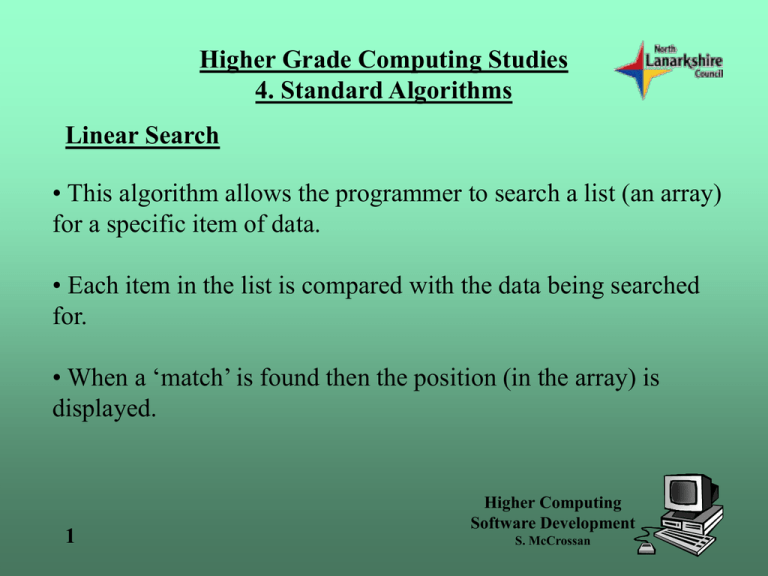4StandardAlgorithms
advertisement

Higher Grade Computing Studies 4. Standard Algorithms Linear Search • This algorithm allows the programmer to search a list (an array) for a specific item of data. • Each item in the list is compared with the data being searched for. • When a ‘match’ is found then the position (in the array) is displayed. 1 Higher Computing Software Development S. McCrossan Higher Grade Computing Studies 4. Standard Algorithms Linear Search • Let's say we have a list of 10 numbers in an array. (The top number only shows the position of each box in the array). 1 2 3 4 5 6 7 8 9 10 3 64 18 2 64 98 2 100 1 2 • We want to look for the number 64. We can see that it appears twice on the list, at positions 2 and 5. 2 Higher Computing Software Development S. McCrossan Higher Grade Computing Studies 4. Standard Algorithms Linear Search 1.1 ask for item being searched for 1.2 get item being searched for 1.3 FOR each item in the list 1.4 IF item_in_list = item being searched for THEN 1.5 report position in list 1.6 END IF 1.7 END FOR loop 3 Higher Computing Software Development S. McCrossan Higher Grade Computing Studies 4. Standard Algorithms Counting Occurrences • This algorithm allows the programmer to count how many times an item of data appears in a list (an array). • Each item in the list is compared with the item of data being counted. • When a ‘match’ is found, one is added to the total number of occurrences. 4 Higher Computing Software Development S. McCrossan Higher Grade Computing Studies 4. Standard Algorithms Counting Occurrences • Let's say we have a list of 10 numbers in an array. (The top number only shows the position of each box in the array). 1 2 3 4 5 6 7 8 9 10 3 64 18 2 64 98 2 100 1 2 • We want to count how many times the number 2 appears in the list. We can see that it appears three times in the list. 5 Higher Computing Software Development S. McCrossan Higher Grade Computing Studies 4. Standard Algorithms Counting Occurrences 1.1 1.2 1.3 1.4 1.5 1.6 1.7 1.8 1.9 6 set counter to zero ask for item being counted get item being counted FOR each item in the list IF item_in_list = item being counted THEN add 1 to the counter END IF END FOR loop display message showing number of occurrences (counter) Higher Computing Software Development S. McCrossan Higher Grade Computing Studies 4. Standard Algorithms Finding the Maximum • This algorithm allows the programmer to find the highest number in a list (an array). 7 Higher Computing Software Development S. McCrossan Higher Grade Computing Studies 4. Standard Algorithms Counting Occurrences • Let's say we have a list of 10 numbers in an array. (The top number only shows the position of each box in the array). 1 2 3 4 5 6 7 8 9 10 3 64 18 2 64 98 2 100 1 2 • We want to find the highest number in the list. As you can see, it is the number 100. 8 Higher Computing Software Development S. McCrossan Higher Grade Computing Studies 4. Standard Algorithms Counting Occurrences 1.1 1.2 1.3 1.4 1.5 1.6 1.7 9 set ‘largest so far’ to the value of the first item in the list FOR each of the remaining items IF current item > largest so far THEN set ‘largest so far’ = current item END IF NEXT item in list display message showing ‘largest so far’ Higher Computing Software Development S. McCrossan Higher Grade Computing Studies 4. Standard Algorithms Finding the Minimum • This algorithm allows the programmer to find the lowest number in a list (an array). 10 Higher Computing Software Development S. McCrossan Higher Grade Computing Studies 4. Standard Algorithms Counting Occurrences • Let's say we have a list of 10 numbers in an array. (The top number only shows the position of each box in the array). 1 2 3 4 5 6 7 8 9 10 3 64 18 2 64 98 2 100 1 2 • We want to find the lowest number in the list. As you can see, it is the number 1. 11 Higher Computing Software Development S. McCrossan Higher Grade Computing Studies 4. Standard Algorithms Counting Occurrences 1.1 1.2 1.3 1.4 1.5 1.6 1.7 12 set ‘smallest so far’ to the value of the first item in the list FOR each of the remaining items IF current item < smallest so far THEN set ‘smallest so far’ = current item END IF NEXT item in list display message showing ‘smallest so far’ Higher Computing Software Development S. McCrossan
![Systems Software 1 [pps]](http://s2.studylib.net/store/data/005419302_1-897cf02cd0c88c582e0cc1a66dfe3efe-300x300.png)







